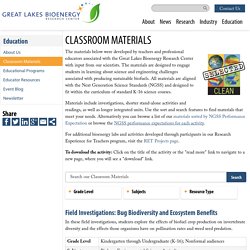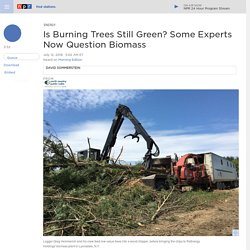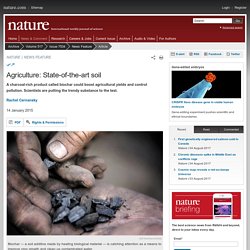

Great Lakes Bioenergy Research Center. The materials below were developed by teachers and professional educators associated with the Great Lakes Bioenergy Research Center with input from our scientists.

The materials are designed to engage students in learning about science and engineering challenges associated with producing sustainable biofuels. All materials are aligned with the Next Generation Science Standards (NGSS) and designed to fit within the curriculum of standard K-16 science courses. Is Burning Trees Still Green? Some Experts Now Question Biomass. Logger Greg Hemmerich and his crew feed low-value trees into a wood chipper, before bringing the chips to ReEnergy Holdings' biomass plant in Lyonsdale, N.Y.

David Sommerstein/NCPR hide caption toggle caption David Sommerstein/NCPR Logger Greg Hemmerich and his crew feed low-value trees into a wood chipper, before bringing the chips to ReEnergy Holdings' biomass plant in Lyonsdale, N.Y. David Sommerstein/NCPR. Activity 4.1. Have students place a “chemical energy card” on the reactants side of their placemat, along with their amino acids, fatty acids, glycerol and glucose molecules.

Coach students to simulate the actual process of dehydration synthesis by making a water molecule each time they tape two monomers together. This helps show that each time a bond is broken a chemical reaction takes place and new bonds form. Hardwoodbiofuels. Exploring ethanol activity. Agriculture: State-of-the-art soil. Jeff Hutchens/Getty Biochar — a soil additive made by heating biological material — is catching attention as a means to improve crop growth and clean up contaminated water.

For more than 150 years, the Brooklyn Navy Yard constructed vessels that helped to stop the slave trade from Africa, lay the first undersea telegraph cable and end the Second World War. CTIME - Ecosystems. 2015 - 2016 Field Test Version Principal Authors Jenny Dauer, School of Natural Resources, University of Nebraska-Lincoln Charles “Andy” Anderson, Department of Teacher Education, Michigan State University.

Lizard Evolution Virtual Lab. Climate Educator Guide. Carbon is the fourth most abundant element on Earth and necessary for all life.

Yet it is the same element which is a component of carbon dioxide (CO2), a greenhouse gas famous for its effect on Earth’s climate and rising temperatures. During these lessons, students will begin to discover the relationship between CO2 and the Earth’s climate, as well as the intricate path of the carbon cycle and how carbon in the atmosphere is connected to living things. Students will also explore the role forests play in climate change, and how communities -- such as Carmelita, Guatemala -- are taking part in the UN initiative REDD+ to help protect forests while fighting climate change. Classroom Activities: What is My Carbon Footprint? MSU Extension Forestry - Wood Slab Energy. Belgian scientists look for biofuel clues in panda poo. Estimation of biomass and its nutrients content. Another month, another global heat record broken — by far. WASHINGTON — Earth dialed the heat up in June, smashing warm temperature records for both the month and the first half of the year.

Off-the-charts heat is "getting to be a monthly thing," said Jessica Blunden, a climate scientist for the National Oceanic and Atmospheric Administration. "This is the third month this year that we've broken the monthly record. " "There is almost no way that 2015 isn't going to be the warmest on record," she added. NOAA calculated that the world's average temperature in June hit 61.48 degrees Fahrenheit (16.33 Celsius), breaking the old record set last year by 0.22 degrees (.12 degrees Celsius). Usually temperature records are broken by one or two one-hundredths of a degree, not nearly a quarter of a degree, Blunden said.
Mountain Pine Beetle. Mountain Pine Beetle by D.A.

Leatherman, I. Aguayo, and T.M. Mehall* (9/11) Quick Facts... Bark-beetles-brochure. Bulls and bugs: Four-year study examines pine beetle's impact on elk habitat in the Elkhorns. National Geographic Magazine - NGM.com. By Hillary Rosner One chilly morning in October 2013, Diana Six parked her white Subaru at the edge of a pine forest in southwestern Montana’s Big Hole Valley.

Beneath snow-tipped peaks, lodgepole pines in four different colors draped the hillside—a time line of carnage. The gray ones, now just trunks and branches, had died in 2009. Light red trees, still holding needles, had succumbed in 2011. Bark beetle kill leads to more severe fires, right? Well, maybe. By Gail WellsHigh Country News Posted: 06/24/2012 01:00:00 AM MDT The lodgepole pine and spruce-fir forests of the Intermountain West are reeling under a one-two punch: more frequent and severe wildfires, and an epidemic of tree-killing bark beetles.

Once-green forests are filled with red dying trees and patches of gray dead ones. The Coal That’s Good for the Climate — NOVA Next. In northern Senegal, near Ross-Bethio, it’s mid-day, the time when the sun is at its hottest. I’m meeting Alioune Diatta in the middle of a field, and he’s wearing the pinched expression of someone wrung out by too much sun and too much sweat. “The farmer is the unluckiest person in the world,” he tells me right away after introducing himself.
Almost 20 years ago, Diatta moved from the lush and semi-tropical Casamance region to the arid northern part of Senegal, a landscape marked by its sandy soils, its dry earth-moving winds, and its short rainy seasons. National Geographic Magazine - NGM.com. Historically the mountain pine beetle’s primary host has been the lodgepole pine. In the north, where lodgepoles dominate the landscape, cold temperatures helped keep beetle populations in check; down south the insects had far fewer trees to infest.
With forests increasingly warmed by climate change, the beetles are thriving in once inhospitable areas, attacking species of pine they rarely touched before—and drastically altering the landscape. New hope for beetle-killed landscapes. From the air, they look like brittle, dead landscapes: millions of acres of scratchy brown pipe cleaners and toothpick logs. Since the 1990s, naturally-occurring bark beetles have multiplied under the effects of drought, climate change and fire-repressed forests, leading to outbreaks that have ravaged forests and left land managers scrambling to deal with a glut of dead trees.
But 2015 may prove a turning point. The first hopeful news comes from the lab of Richard Hofstetter, a forest entomologist at Northern Arizona University. Working with a private company called Montana BioAgriculture, Hofstetter has identified a deadly strain of the Beauveria bassiana fungus that kills 80 to 90 percent of pine beetles, one of the most destructive bark beetle species of recent years. Beetles.mt.gov. Text Size The main hosts for MPB are pines. The native pine hosts in Montana include: In addition to these native trees, a number of non-native trees planted in Montana can be attacked. Beetles.mt.gov. MTNPineBeetleFinal. Mountain Pine Beetle.
Bark_beetle_outbreaks_students. Name________________________ Changing Planet: Bark Beetle Outbreaks Background Mountain pine beetles (or pine bark beetles) are native to North American trees and are an important component of forest ecosystems. However, over the past 15 years, the pine beetle population has grown faster than the local ecosystems can tolerate. The range of these beetles has also expanded. CarbonTIME. EnvLit - Working Groups.
As Uses of Biochar Expand, Climate Benefits Still Uncertain by Mark Hertsgaard: Yale Environment 360. Frequently Asked Questions about Biochar. CNN, Anderson Cooper 360° - Biochar to Save the Planet. As Uses of Biochar Expand, <br />Climate Benefits Still Uncertain. Biochar Websites. NASA - Help for the Environment. Can 'biochar' save the planet? Can 'biochar' save the planet? Carbon Sequestration - Home. US Biochar Initiative. US Biochar Initiative. International Biochar Initiative. Biochar Farms. University_of_Hawaii_article_1-3-11.pdf. NASA satellite will map soil moisture. Measurement of Soil Moisture. BANR Bioenergy. Bulls and bugs: Four-year study examines pine beetle's impact on elk habitat in the Elkhorns. Beetle kill prompts tree removal on MacDonald Pass.
Cars do not need to idle to warm up in cold weather. Carbon Cycle ( Read ) Exploring Energy Transformations in Plants. Great Lakes Bioenergy Research Center. Www.energy.gov/sites/prod/files/2014/10/f18/bioenergize_me_toolkit.pdf. Biofuels Basics. Feedstock Supply. Biochar - A Multitude of Benefits. Great Lakes Bioenergy Research Center. Great Lakes Bioenergy Research Center. The Carbon Cycle : Feature Articles. What is the Carbon Cycle? What is the science behind it? Carbon Mitigation Initiative: Stabilization Carbon Crisis Game. The Carbon Cycle Game. A Student's Guide to Global Climate Change. ESRL Global Monitoring Division - Global Greenhouse Gas Reference Network. Colorado ethanol producer begins shift from corn to woody biomass.